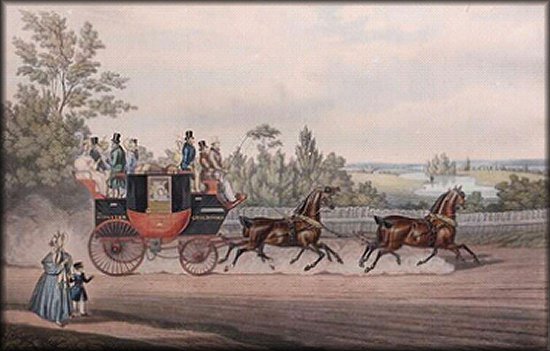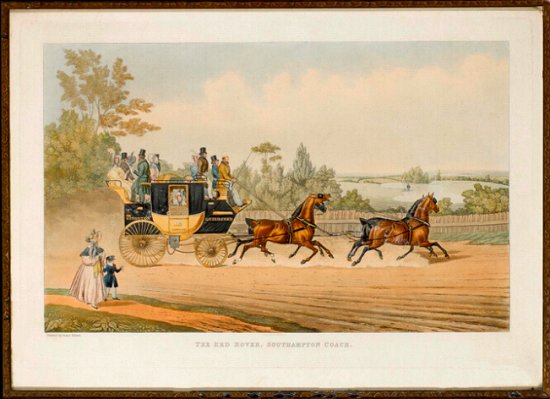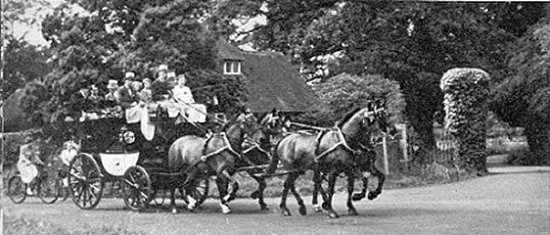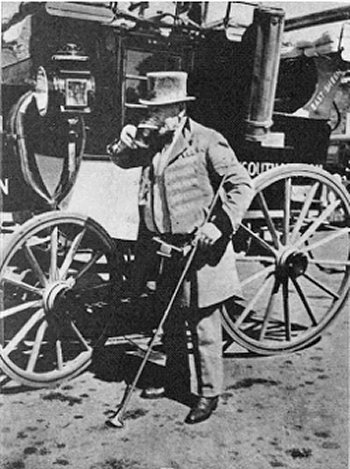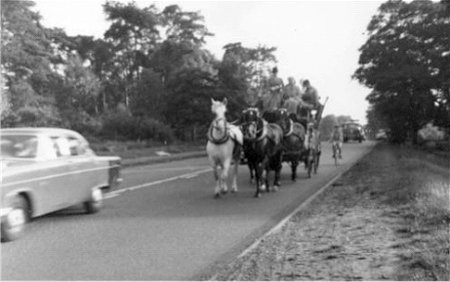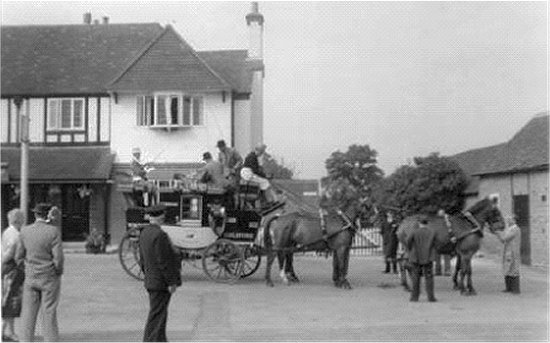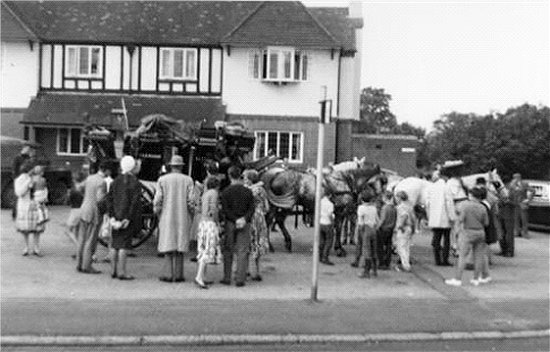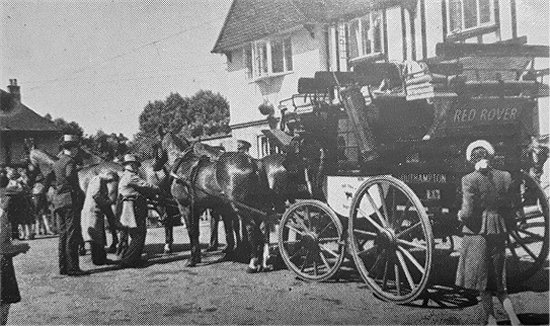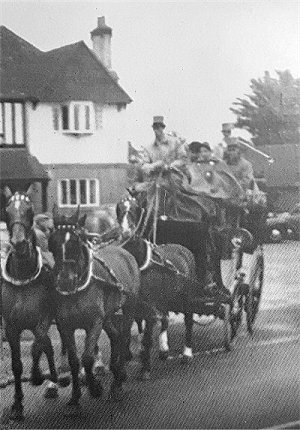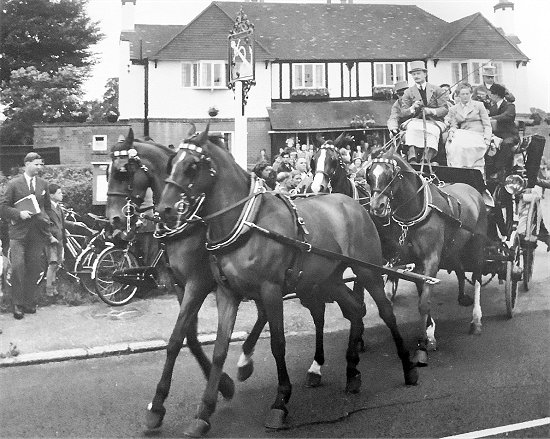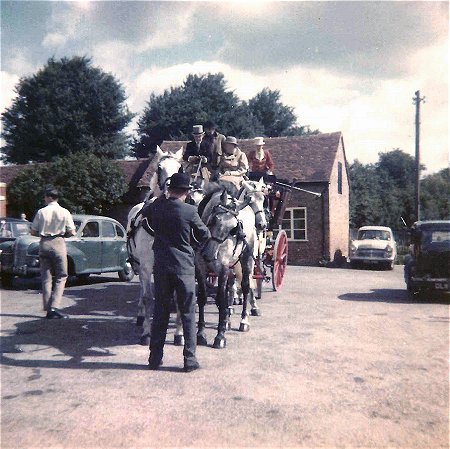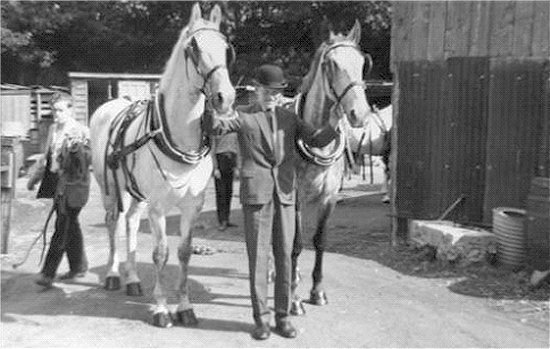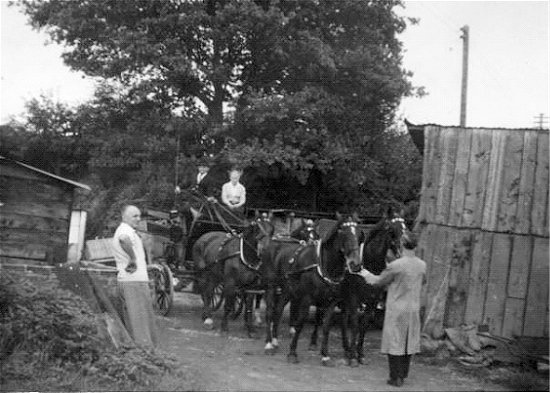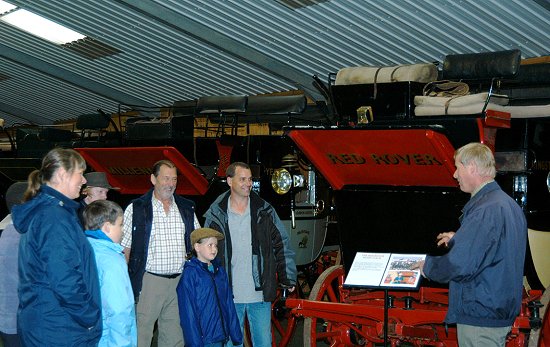The midday coach from London to Southampton used to drop off the Times newspaper at the top of Cranmore Lane in Aldershot (amongst other places). When the paper with news of the victory at Waterloo in 1815 arrived at nearby Ayling House the bell was rung to call the men together from the fields to join in the rejoicing.
In the mid-1800s the railways rapidly took over from the coach network and according to one source the last of the old regular stagecoaches, the London to Brighton 'Age' ceased to run in 1862. However, an undated flyer advertising the Red Rover London to Southampton coach is headlined 'the only Coach now on the Road' and it was described in the press as 'the last coach to compete on a route served by railways' until it ceased in 1843. The proprietor of the service was Robert Gray and Co who was 'Carrier in Ordinary' to King William IV and Queen Victoria. The coach ran from the Bolt-in-Tun, Fleet Street to the Royal Hotel, Southampton via Kingston, Guildford, Farnham, Alton, Alresford and Winchester. The Bolt-in-Tun was at 64 Fleet Street from the 15th century until it was demolished in 1853.
Mr Sanders Watney, a director of Watney Combe Reid and Co, was a keen coachman and a member of the Coaching Club of Great Britain. In 1950 Watney & Co purchased the historic Red Rover coach and restored it to its original magnificent condition. In September 1951 the coach returned to Guildford and Farnham driven by Mr Watney as part of a tour 'to offer towns and villages a breath of the spirit of the old coaching days'. In August 1952 Watney organised a revival of the Red Rover's original route from London to Southampton, with help from the Coaching Club and horse-team owners. Nine teams were involved and Mr Watney horsed and drove the first two stages out of London, assisted by Mr George Mossman an experienced coachman. The guard throughout was Mr Harry Love, one of the last of the professional coach guards, who gave warning of their approach with a fanfare on a long coaching horn. The 1952 re-enactment started at 7:15 am on Monday 11th August when the coach set off from the Stag Brewery in Allington Street, Pimlico, London, Watney & Co's headquarters, drawn by their team of short-tailed chestnuts. It proceeded to stops at 8:25 at the Bull in East Sheen, through Richmond Park and Thames Ditton to the Wheatsheaf in Esher at 10:00 where there was a 15-minute stop for breakfast, through Cobham to the Jovial Sailor in Ripley at 11:15, then 12:40 at the Anchor in Normandy and 2:05 at the Marlborough Head in Farnham where there was a 30-minute stop for lunch. They only allowed half an hour for lunch, though this was an improvement on the old coaching days when lunch-time was cut to 20 minutes.
The next stop was 3:20 at the Swan in Alton, then 4:50 at the Bell in Alresford, 6:15 at the end of the bypass in Compton (four miles from Winchester) and they arrived at 7:30 pm at the Red Lion in Southampton. There was a change of horses at each of the stops, which were about ten miles apart. The timing of the whole journey was very tightly controlled, planning to travel at 8 miles per hour and allowing 8 minutes for each change of horse teams. The total journey was 86½ miles. Each of the nine team owners had a seat in the coach for the whole way and could bring a friend for the box seat during his own drive. This plus one groom and the guard accounted for 12 of the 14 outside seats and they promised to carry one member of the press or BBC each day. According to Mrs Watney who accompanied them on all the journeys "in the old coaching days the route to Farnham over the Hogs Back was usually favoured although the lower road was also used, but we decided to use the latter and avoid the steep hills". Most of the stops were at Watneys' inns but the Anchor and the Swan at Alton were Courage pubs. Because there was no inn at the Compton stop they provided refreshments from Watneys' Container Beer Demonstration Van, which caused a good deal of amusement. The return journey left Southampton at 8:15 am on Tuesday and proceeded via the same stops in reverse order, with 30 minutes for lunch in Alton and 15 minutes for tea in Ripley. The whole process was repeated on Wednesday and Thursday. The event was widely reported in the press, as far afield as the Chelsea News, Diss Express, Hartlepool Northern Mail, two Birmingham dailies and the Dumfries & Galloway Standard, as well as the more local Surrey Advertiser. In its third week of coverage the Surrey Ad struck a sombre note with a long article about the perils of stagecoach travel in the winter in Victorian times. The West Sussex Gazette was the only publication to mention an unscheduled attempt by two youths in 16th century costume to 'hold up' the coach between Four Marks and Alton. From the 10th to 13th of August 1953 a second re-enactment of the London to Southampton runs was staged and most of the horses in the nine teams had recently taken part in the Coronation procession in June. The whole route was described in the Aldershot News, including from the Guildford bypass turning right at the Wooden Bridge to Normandy and Ash, then turning left at the Prince of Wales pub in Aldershot (demolished in 2012) onto the Lower Farnham Road to Badshot Lea and Farnham. From this description it is clear the coach did not go up onto the Hog's Back on this occasion. The 1953 event was covered in the Esher News but not so widely elsewhere. The Esher News describes the coach "gleaming red and black in the sunshine at the Wheatsheaf Inn. Inside the coach the narrow seats hold four slim companions and unwanted top hats could be fastened to the ceiling by black silk cords". Few of the onlookers noticed the modern shooting brake following unobtrusively carrying Mr JF Wells with his tools "just in case the whole lot breaks down". In 1954 the Red Rover re-created the London to Brighton run and attended the Aldershot Show where it won first prize in the road coaches class. There is no mention in the press in 1955.
The 1956 repeat of the London-Southampton run followed a similar route, from the Stag Brewery at 7 am on Monday 13th of August to the Red Rover inn at Barnes instead of East Sheen, by request of the landlord who had recently renamed the inn, then from Esher to Alresford as before and a stop at the Bridge in Shawford instead of Compton, arriving in Southampton at 7:30 pm. The Bell at Alresford was one of the few genuine coaching inns which remained in its original state at this time. They tried a new and prettier route from Ripley to Normandy via Jacobs Well but were confronted by road works which caused them some difficulty. The residents of Winchester made a special request for the coach to go through the city and the Hampshire Telegraph reported "the sound of a coaching horn at the junction of Winchester High Street and Southampton Road". There was a return journey on Tuesday and a repeat of both on the Wednesday and Thursday, with Mr D Sanders aboard as guard. The coach averaged seven miles per hour and Mr Watney said that "the modern slippery road surface precludes the coach achieving anything like the speed which old-time coaches achieved on grit macadam roads". Nevertheless it was reported to have 'a fine record for punctuality'. Mrs Watney reported that "these days it is seldom possible to gallop but at Shawford Sir Dymock White's horses made a most rapid and spectacular ascent up the hill to the delight of the onlookers and passengers". In 1957 the Red Rover was in Dover and also repeated the London to Brighton run. In May 1959 it appeared again in the programme of the Aldershot Show, competing in the four-in-hand Road Coaches class, being driven by Mr S Watney round the Coaching Marathon course starting by the Officers' Club on Farnborough Road, along Laffans Road, Aldershot Road, Bourley Road and into the Rushmoor Arena. We don't know the exact route of the 1958 London-Southampton event except that they stopped at the Marquis of Granby in Esher, and at the India Arms Mr Watney presented the people of Winchester with a Georgian coaching horn. The next re-enactment in 1962 didn't really start in London at all. The coach departed the Bull at East Sheen at 7:15 am on Monday 27th of August and proceeded by the same stops as 1956 to Alresford, then the India Arms at Winchester and the White Horse at Ampfield before arriving at the Red Lion in Southampton at 7:30 pm. The return journeys on Tuesday and Thursday followed the same route and terminated at East Sheen. Mr H E Sanders was the guard in 1962, possibly a relative of the 1956 guard. A brief report in the Esher News reported that Red Rover had established a new world record for coaching changeover at the International Horse Show in 1960. After this 'the increase in traffic finally beat him' and there were no more runs.
In the 1952 event, WA Gilbey's team of bays drove from Ripley to the Anchor at Normandy and Lt Col HCR Gillman RA took over with the Royal Artillery and Royal Military Academy team of bays for the stretch to the Marlborough Head in Farnham. In 1953 Capt. RL Seaman drove the Normandy to Farnham stretch with the RA and RMA's team of bays. In 1956 Major Ian Fraser took over with the RA (Sandhurst) team and in 1958 the RA (Sandhurst) team was driven by Major S Eiloart.
Interested bystanders would gather to watch, as shown in photographs of the event. They did not have long, because the timing was tightly controlled and only allowed eight minutes for each change of horse teams. The horses were housed at Sandpit Farm, 24 acres opposite Wyke school on School Lane, which was occupied by John Wallace from the 1940s to the 1980s. He was groom for the commanding officer of a military regiment, so was involved with the military horse teams which took part in the Red Rover re-enactments. David Swabey used to help him at the farm in the school holidays - they kept pigs and chickens and had a 'house cow'.
In 1970 it had a logo on the door 'The Bull East Sheen' and the wording 'London Kingston Ripley Southampton' on the bodywork. In the 1970s it was part of the collection at Breamore Carriage Museum at Fordingbridge, Hampshire, but it was still owned by Mr Watney until he gave it to Mr Jim Corbett in 1975. Mr Corbett was lucky enough to drive it at most of the Agricultural Shows from 1968 until 1975 when he had to retire the team.
Numerous newspaper articles from the British Newspaper Archive online,
1951-1973, including: Material relating to Ventham Coachbuilders of Leatherhead and Dorking, with timetables of the 1952, 1956 and 1962 re-enactments. Surrey History Centre ref. 4414/2/19. Painting on a modern Christmas greetings card. Surrey History Centre ref. PX/72/36. Postcard c.1970 from Breamore Carriage Museum. Surrey History Centre ref. PC/139/14. Victorian flyer advertising the Red Rover, copy on page 42 of History of Tongham by Geoffrey Birch (typescript 1964 revised 1973) at Ash library. No apparent reference in the text. Aldershot Historical and Archaeological Society no.4, Dec 1986, p.3, re. Times newspaper at Cranmore Lane. Ash Rate books re. Sandpit Farm, Normandy. Breamore Country Museum (formerly Carriage Museum) at Fordingbridge, Hampshire SP6 2DF. Pubhistory.com online re. the Bolt in Tun, Fleet Street. Watney & Co 'Red Barrel' house magazines at Richmond Local Studies library ref. AD87, in seven boxes. Include articles by Mrs Watney describing the first four re-enactments, in the editions for Aug 1952 p.305, Sept 1953 p.269, Oct 1956 p.335 and Oct 1958 p.360. Watney Combe Reid & Co archives at Glasgow University - no apparent
references. Mr Jim Corbett, the current owner, re. manufacture by Shanks and 'the increase in traffic'. Photos from Madeline Buttner probably taken by Joyce Thornton, her mother.
|

